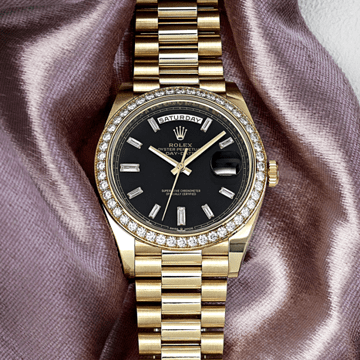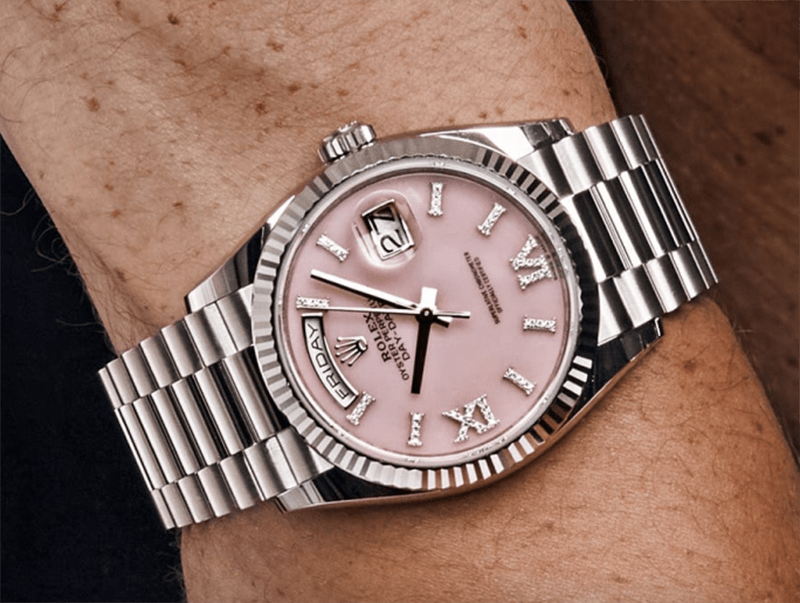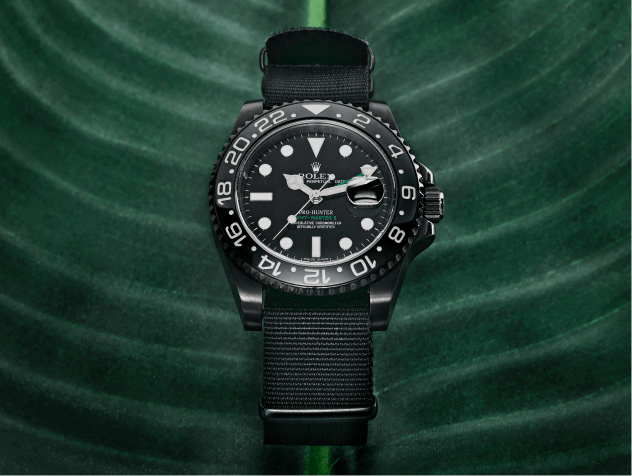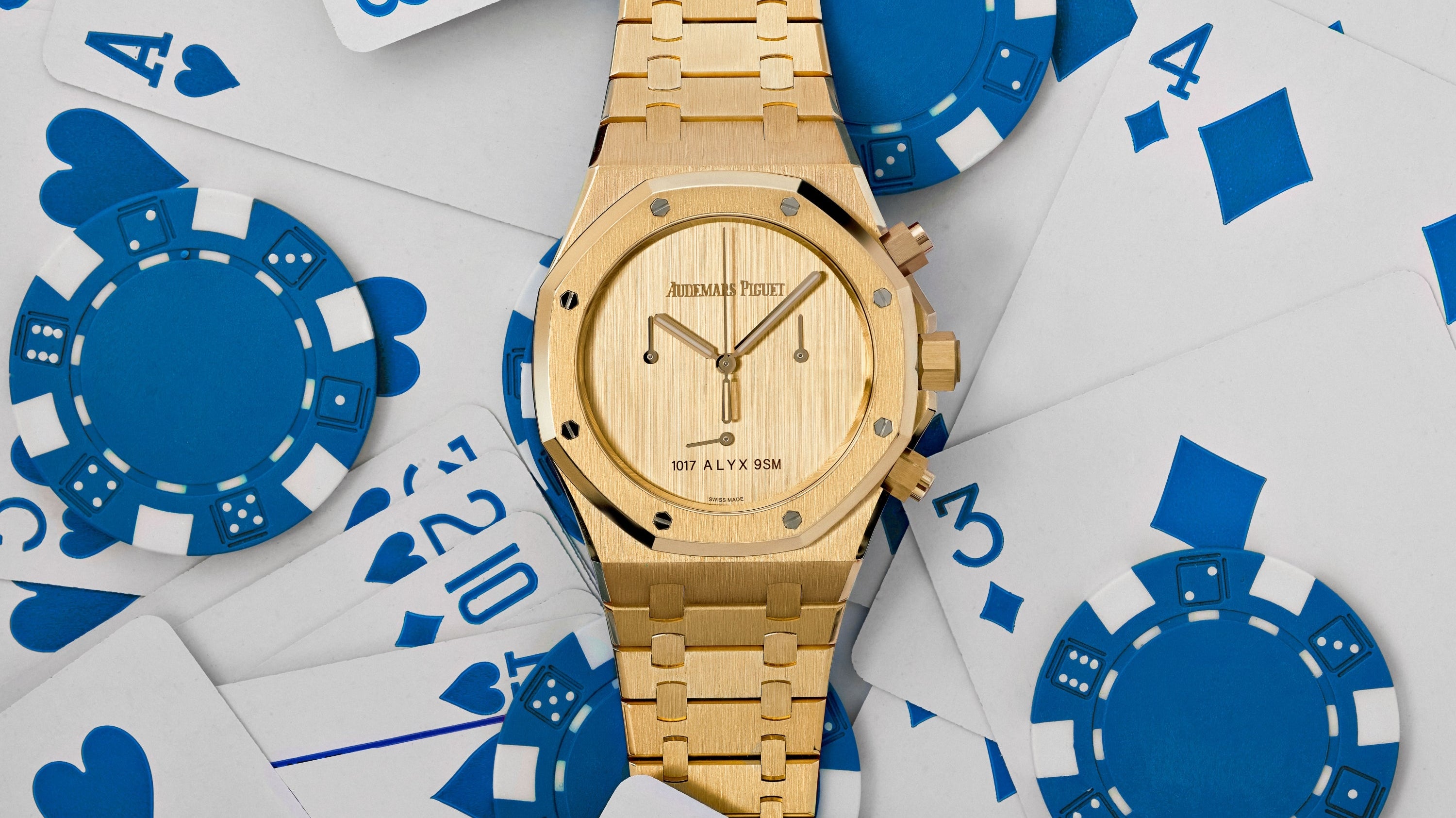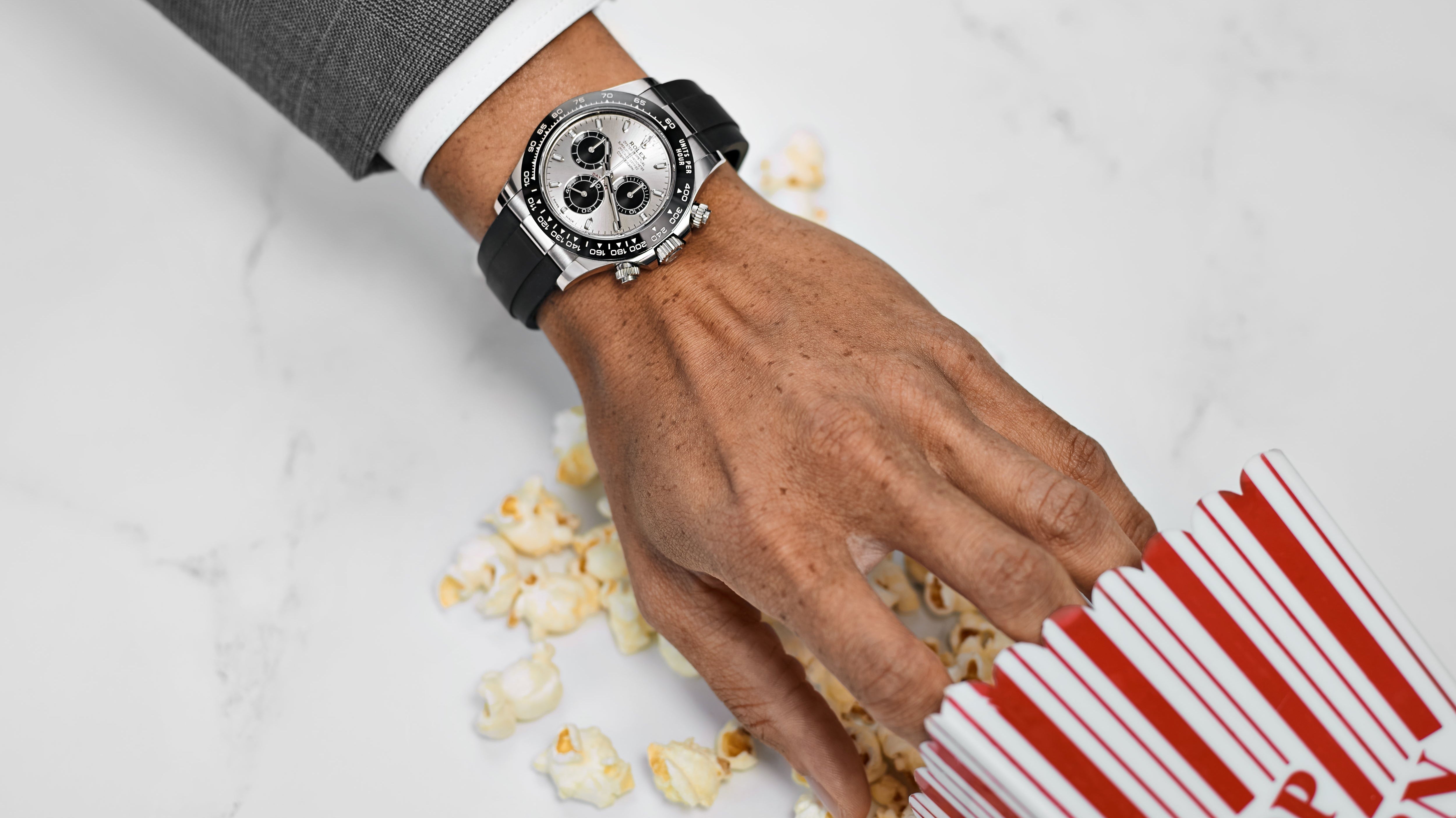As the detail responsible for the famous “Pepsi” nickname, a half-red and half-blue bezel is emblematic of Rolex’s GMT watches, and it was the original style that appeared on the inaugural GMT-Master from 1955. Over the decades, the Pepsi bezel has evolved with the collection, and even in the years since Rolex updated the model to become the GMT-Master II in the 1980s, there have been three very different versions of this iconic red and blue design. Additionally since all Rolex GMT-Master II watches with this bezel colorway go by the same “Pepsi” nickname, there are technically seven different Rolex GMT-Master II Pepsi references that exist (as of January 2024), and examples range from humble stainless steel models, all the way up to exclusive off-catalog models that are crafted entirely from solid 18k with their signature red and blue bezels assembled entirely from colored gemstones.
About the Rolex GMT-Master II Pepsi
While some Rolex nicknames only apply to one specific version of a single reference, others are used to describe many different models that share the same defining characteristic, and the “Pepsi” nickname applies to any Rolex GMT-Master or GMT-Master II watch with a split-color red and blue bezel. Not counting all of the vintage GMT-Master watches, there are seven distinct GMT-Master II Pepsi references, with three of them being off-catalog models that are encrusted in gemstones and were never formally offered for sale to the general public.
With that in mind, although a Rolex GMT-Master II Pepsi can exist in a variety of different forms, all versions are united by a few key features such as their 40mm Oyster cases, sapphire crystals, automatic GMT movements with independent local hour hands, and split-color red and blue bezel inserts. From here, the definition of a Pepsi GMT-Master II can start to get a bit more nebulous, and before you even get into all of the various off-catalog and discontinued references, just Rolex’s current catalog has two different versions of the GMT-Master II Pepsi, among which there are two different metals, three different styles of dials, and two types of bracelets.
Rolex GMT-Master II Pepsi History
When Rolex first updated its multi-timezone pilot’s watch collection to become the GMT-Master II in 1982, a red and blue Pepsi bezel was not originally available for the model, and Rolex instead initially only offered the stainless steel GMT-Master II with a red and black “Coke” bezel insert. However, by the time Rolex introduced the second version of the Rolex GMT-Master II (ref. 16710) in 1989, the Pepsi bezel was once again available as an option within the collection. During this era, Rolex still used anodized aluminum as the material for its bezel inserts, and the aluminum Pepsi bezels fitted to the GMT-Master II 16710 are largely identical to the style that can be found on vintage GMT-Master watches.
Between 2005 and 2007, Rolex updated the entire GMT-Master II collection to feature bezel inserts made from its proprietary Cerachrom ceramic material. However, it was not yet within Rolex’s manufacturing capabilities to produce a ceramic version of the model’s signature red and blue Pepsi bezel, and all of the standard-production GMT-Master II watches were fitted with single-color black Cerachrom bezels, regardless of their metal type or configuration. With that in mind, to say that the Pepsi bezel had disappeared entirely is not quite accurate and in 2006, Rolex unveiled the yellow gold ref. 116758SARU as one of its lavish off-catalog offerings, which features a diamond-set case, along with a red and blue Pepsi bezel assembled entirely from precious gemstones.
Using ruby and sapphire for its red and blue sections, along with white diamonds to denote the locations of its hour markings, this ultra-lavish version of the Pepsi GMT-Master II bezel was used again on the white gold ref. 116759SARU that debuted the following year in 2007. However, it’s important to note that both of these luxurious gem-set watches were off-catalog models, and in addition to being produced in incredibly small numbers, they were also only available to Rolex’s top VIP customers and never listed on the brand’s official website. Consequently, it would not be until the 2014 release of the white gold ref. 116719BLRO that there would be a standard-catalog Rolex GMT-Master II watch with a red and blue Pepsi bezel, and rather than being made from anodized aluminum or gemstones, the bezel fitted to the ref. 116719BLRO featured the same split-color design, although it was now constructed from a single piece of the brand’s Cerachrom ceramic material.
In 2018, Rolex introduced a new stainless steel GMT-Master II Pepsi (ref. 126710BLRO) that featured the ceramic version of its signature red and blue bezel, and that very same year, the brand also updated the white gold Pepsi model to feature a Midnight Blue dial as a way to visually separate it from the newly released stainless steel version. One year later in 2019, Rolex added a meteorite dial as an option for the updated white gold GMT-Master II Pepsi (ref. 126710BLRO), and the brand also quietly released the ref. 126755SARU as one of its exclusive off-catalog offerings, which expands upon the core concept of its two gem-set predecessors with the use of Everose gold for its case and bracelet components. Just like the yellow gold and white gold off-catalog models, the Everose gold Pepsi GMT-Master II 126755SARU features diamonds set into its lugs and crown guards, along with a split-color bezel that is assembled from rubies, sapphires, and diamonds.
As of January 2024, the two standard-production Rolex GMT-Master II Pepsi models are the stainless steel ref. 126710BLRO and the 18k white gold ref. 126719BLRO. While both of these Pepsi GMT-Master II models are powered by the same Cal. 3285 movement and offer the same 40mm case profile, they differ when it comes to their dials and bracelet options. The stainless steel Rolex GMT-Master II 126710BLRO features a black dial, and is available with the option of either the Oyster or Jubilee bracelet. Meanwhile the white gold 126719BLRO is exclusively fitted with an Oyster bracelet in matching 18k white gold, although it is available with the option of either a Midnight Blue dial or one that is crafted from a slice of genuine meteorite.
GMT-Master II Pepsi Key Features
- Model Name: Rolex Oyster Perpetual GMT-Master II
- Reference Numbers: 16710, 116719BLRO, 126719BLRO, 126710BLRO, 116758SARU, 116759SARU, 126755SARU
- Year of Introduction: 1989 (16710); 2006 (116758SARU); 2007 (116759SARU); 2014 (116719BLRO); 2018 (126719BLRO and 126710BLRO); 2019 (126755SARU)
- Popular Nicknames: “Pepsi”
- Materials: Stainless steel (16710 and 126710BLRO); Yellow gold (116758SARU); White gold (116759SARU, 116719BLRO, and 126719BLRO); Everose Gold (126755SARU)
- Case Size: 40mm
- Functionality: Hours, minutes, seconds, date display, secondary timezone w/ independent local hour hand
- Bezel: Bidirectional rotating w/ red and blue split-color insert (aluminum, ceramic, or gem-set)
- Dials: Black, Midnight Blue, Meteorite, or Diamond-Paved
- Hands: 18k Gold (Mercedes-style)
- Crystal: Sapphire (flat w/ Cyclops magnification lens)
- Movement: Rolex Cal 3185, Cal. 3186, or Cal. 3285 (automatic winding)
- Notable Details: Diamond-set lugs and crown guards (116758SARU, 116759SARU, and 126755SARU)
- Water Resistance: 100 meters / 330 feet
- Bracelet: Oyster bracelet (all references); Jubilee bracelet (126710BLRO); Diamond-set Oyster bracelet (116758SARU, 116759SARU, and 126755SARU)
Pepsi GMT-Master II Bezel Types
Aluminum — The first type of Pepsi GMT-Master II bezel is only going to be found on the ref. 16710, which was produced from approximately 1989 until 2007. This style of Pepsi bezel is the same as what Rolex used on vintage GMT-Master watches, and it is constructed from a thin piece of aluminum that has been anodized to provide it with its signature red and blue split-color design.
Ceramic — The second type of Pepsi GMT-Master II bezel is made from Rolex’s proprietary Cerachrom ceramic material, and despite having a split-color design, the insert is constructed from a single piece of ceramic. First introduced on the white gold ref. 116719BLRO in 2014, the ceramic Pepsi bezel is the style used on both of the current-production Rolex GMT-Master II Pepsi models.
Gem-Set — Only found on the exclusive off-catalog versions of Rolex’s legendary travel watch, the third type of Pepsi GMT-Master II bezel is constructed entirely from precious gemstones. The split-color red and blue sections are represented by rubies and sapphires, while diamonds take the place of the numerals that would normally exist on the standard GMT-Master II Pepsi bezel inserts.
Rolex GMT-Master II Pepsi Models
Including the off-catalog models that were never officially part of Rolex’s formal lineup, there have been a total of seven different GMT-Master II Pepsi references that have been put forward over the years.
GMT-Master II 16710
Produced from approximately 1989 until 2007, the Rolex GMT-Master II ref. 16710 was the last model from the collection to feature an aluminum bezel, and one of the insert options available for it was the red and blue Pepsi version. Powered by the Cal. 3185 movement (later models received the Cal. 3186), the GMT-Master II 16710 is functionally very similar to modern GMT-Master II references; however, from an aesthetic standpoint, it has far more in common with its vintage predecessors. Along with having a different case profile with a smaller style of winding crown, the aluminum Pepsi bezel on the ref. 16710 also provides this model with an inherently more retro overall appearance.
GMT-Master II 116719BLRO
Crafted entirely from 18k white gold, the Rolex GMT-Master II ref. 116719BLRO was the first model to feature a ceramic Pepsi bezel insert. Launched in 2014 and discontinued just a few years later in 2018, the ref. 116719BLRO was originally fitted with a black dial. However, when Rolex discontinued the GMT-Master II 116719BLRO and introduced its replacement with a Midnight Blue dial, the brand allowed owners of the original white gold Pepsi GMT-Master II to swap out their black dials for the newer style of blue dial. Consequently, you will find examples of the discontinued white gold GMT-Master II Pepsi ref. 116719BLRO that are fitted with both black and Midnight Blue dials.
GMT-Master II 126719BLRO
Launched in 2018 as an update for the original white gold ceramic Pepsi model, the Rolex GMT-Master II ref. 126719BLRO is the current-production version of the white gold GMT-Master II, and it is powered by the new-generation Caliber 3285 movement. While all examples of the ref. 126719BLRO will be fitted with Cerachrom Pepsi bezels and Oyster bracelets, two different dials are available for this model, and in addition to the standard Midnight Blue dial is a meteorite dial that Rolex introduced as an option for the 18k white gold GMT-Master II in 2019.
GMT-Master II 126710BLRO
The Rolex GMT-Master II ref. 126710BLRO is the stainless steel model from the current-production collection that was first launched in 2018 and then updated in 2021 to include the option of the Oyster bracelet. All reference 126710BLRO watches feature black dials, ceramic Pepsi bezels, and the Cal. 3285 movement, although unlike its white gold sibling, Rolex currently offers this stainless steel model with the option of either the Oyster or Jubilee bracelet.
GMT-Master II 116758SARU
The yellow gold Rolex GMT-Master II ref. 116758SARU is the first of the off-catalog Pepsi models that was launched in 2006 with a gem-set version of the collection’s signature red and blue split-color bezel. Powered by the Cal. 3186 movement, all reference 116758SARU watches feature diamond-set lugs and crown guards, although examples can be found with either black or diamond-paved dials, along with either standard yellow gold Oyster bracelets or ultra-luxurious versions with diamond-set center links.
GMT-Master II 116759SARU
Released in 2007 as a follow-up to the original gem-set Pepsi model, the Rolex GMT-Master II ref. 116759SARU is the white gold version that features the same diamond-set case and split-color bezel assembled from red rubies and blue sapphires. Just like its yellow gold sibling, the white gold GMT-Master II 116759SARU was only ever available to Rolex’s top VIP customers, and examples can be found with both black and diamond-paved dials, along with the option of either standard or diamond-set Oyster bracelets.
GMT-Master II 126755SARU
The Rolex GMT-Master II ref. 126755SARU is the most recent off-catalog Pepsi model that was quietly unveiled in 2019. Just like its yellow and white gold predecessors, the ref. 126755SARU features a diamond-set case, along with a gem-set rendition of the collection’s signature red and blue Pepsi bezel. However, unlike the previous two off-catalog Pepsi models, the GMT-Master II 126755SARU is crafted from Rolex’s proprietary Everose gold alloy, and it is powered by the new-generation Caliber 3285 movement. With that in mind, just like the previous gem-set Pepsi models, examples of the Everose gold the ref. 126755SARU can be found with either black or diamond-paved dials, along with either standard or diamond-set Oyster bracelets.
Rolex GMT-Master II Pepsi Price Information
As of January 2024, official retail prices for the Rolex GMT-Master II Pepsi start out at $10,700 USD for the stainless steel ref. 126710BLRO on an Oyster bracelet and top out at $42,900 USD for the 18k white gold ref. 126719BLRO that is fitted with a meteorite dial. With that in mind, just like nearly all of Rolex’s popular models, global demand for the Pepsi GMT-Master II exceeds the supply of watches at a retail level, and all seven references trade hands on the secondary market for values that are higher than their official retail prices.
When it comes to the open-market prices for Rolex GMT-Master II Pepsi watches, the absolute least expensive options will be well-worn examples of the ref. 16710 from the 1990s, with the price of entry currently floating in the $12k to $13k range. Meanwhile, the most expensive Pepsi GMT-Master II watches are naturally the off-catalog models with gem-set bezels that also feature diamond-paved dials and diamond-set bracelets. All three of these ultra-exclusive references are six-figure watches, and the most expensive options currently sit right around the $300k mark on the secondary market.
Since prices are dictated by public demand on the secondary market, a very different landscape exists for the open market prices of Pepsi GMT-Master II watches. For example, the current-production stainless steel Rolex GMT-Master II ref. 126710BLRO trades hands for roughly twice its retail price, while the secondary market premium for the white gold ref. 126719BLRO is typically only a few thousand dollars. Meanwhile, although Rolex only charges an extra $2,300 for the option of a meteorite dial on the white gold Pepsi GMT-Master II when purchased at a retail level, it is not uncommon to see meteorite dial versions of this model selling for premiums of five-figures above their otherwise identical counterparts that are fitted with standard Midnight Blue dials.
While Rolex has produced the GMT-Master II with a wide variety of different bezel colors, the classic split-color red and blue “Pepsi” bezel is the quintessential colorway for the brand’s multi-timezone travel watch, and it has been a celebrated icon in the collectring world ever since it first appeared on the original GMT-Master watches in the mid 1950s. Regardless of the specific materials that Rolex was using for its bezels throughout the years, the brand has always made an effort to keep a red and blue bezel as an option within the GMT lineup, and that has resulted in a wide variety of Pepsi GMT-Master II watches that represent many different expressions of this iconic aesthetic.

